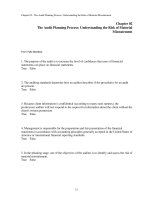Social media marketing a strategic approach 1st edition barker test bank
Bạn đang xem bản rút gọn của tài liệu. Xem và tải ngay bản đầy đủ của tài liệu tại đây (101.27 KB, 3 trang )
Chapter 2—Goals and Strategies
TRUE/FALSE
1. A social media marketing plan does not require monitoring or adjustment during its implementation.
ANS: F
PTS: 1
REF: 26
TOP: Social Media Marketing Planning Cycle
2. The most popular uses for social media are brand awareness and building.
ANS: T
PTS: 1
REF: 29
TOP: Setting Goals
3. Some of a brand's most passionate advocates can start off as disgruntled customers.
ANS: T
PTS: 1
REF: 41
TOP: Self-Promotion vs. Building an Army of Advocates
4. It is very important for brands looking to engage in social media to focus on broadcasting and
promoting their message on these channels at every opportunity.
ANS: F
PTS: 1
REF: 36
TOP: The 8 C's
5. A social media marketing strategy is something that should be developed to support a brand's overall
marketing plan.
ANS: T
PTS: 1
REF: 35
TOP: Determining Strategies
6. Increasing search engine rankings and site traffic are two important goals for brands that social media
marketing cannot help achieve.
ANS: F
PTS: 1
REF: 37
TOP: The 8 C's
MULTIPLE CHOICE
1. Which of the following is not part of the social media marketing planning cycle?
a. Setting goals
b. Tuning
c. Driving traffic
d. Implementing
e. Monitoring
ANS: C
PTS: 1
REF: 26
TOP: The Social Media Marketing Planning Cycle
2. Why is it important to listen to conversations about a brand?
a. To see how many people buy your products.
b. It helps a company evaluate its advertising strategy.
c. It makes your customers think you care about what they say.
d. Listening can help a company identify those keywords people use for its products.
e. Comments can help a company understand how it is perceived and where opportunities
may lie.
ANS: E
PTS: 1
REF: 28
TOP: Stage #1: Listen to conversations about a brand or company
3. Social media marketing goals must be flexible because
a. A brand cannot be sure its goals will be achieved.
b. New developments sometimes occur while using social media.
c. A particular social network might disappear.
d. Consumers are fickle, so it is difficult to forecast their behavior
e. Brand management might not support certain social media marketing goals.
ANS: B
PTS: 1
REF: 29
TOP: Setting Goals
4. What is the primary different between social brand building and traditional brand building?
a. Social brand building is what people say about a company.
b. Social brand building occurs on review sites only.
c. Traditional brand building is not found on the Internet.
d. Social brand building is the same as traditional brand building, but occurs only on social
media.
e. Social brand building is what a company says about itself.
ANS: A
PTS: 1
REF: 32
TOP: Building a Brand
5. Which of the following is not a brand building goal?
a. Increase sales of a product or service
b. Increase awareness for a product or service
c. Expand brand loyalty
d. Improve consumer perception about a brand
e. Position a brand
ANS: A
PTS: 1
REF: 32-33
TOP: Setting Goals
6. What does the Hubspot case study illustrate?
a. Social media marketing is difficult.
b. In order to succeed at social media, a company should post the same content on all social
media sites.
c. Social media marketing only works if lead generation is your goal.
d. A strategic approach to social media is the only way to produce solid, measurable results.
e. Omitting a promotional message in a company's call to action only works if you produce a
lot of content.
ANS: D
PTS: 1
REF: 38
TOP: Case Study: Hubspot
7. A call to action can be defined as
a. The action you want someone to take at each stage of your marketing campaign
b. Lead generation and/or sales
c. The objectives of a social media campaign
d. The process of measuring a social media campaign
e. Brand building
ANS: A
PTS: 1
REF: 39
TOP: Call to Action
8. When developing social media strategies, it is important that companies
a. Look to what their competitors are doing
b. Ensure they include Facebook, because it is one of the most popular social networks
c. Include the 8 C's
d. Make sure to adapt them to their individual strengths, weaknesses, opportunities and
threats.
e. Define the call to action first
ANS: D
PTS: 1
REF: 35
TOP: Determining Strategies
9. Which of the following is not considered a social media marketing goal?
a. Increasing customer satisfaction (customer service)
b. Driving recommendations from friends and family
c. Generating new leads
d. Crisis communication and online reputation management
e. Increasing the number of Facebook fans & Twitter followers
ANS: E
PTS: 1
REF: 33-34
TOP: Setting Goals
10. Which of the 8 C's refer to understanding the etiquette, nuances and spoken or unspoken rules of a
particular social media platform?
a. Convert
b. Categorize
c. Collaborate
d. Comprehend
e. Contribute
ANS: D
PTS: 1
REF: 36
TOP: The 8 C's
11. Dell's social media case study illustrates that
a. Twitter is an important channel for customer service.
b. Collaboration isn't as important as converting.
c. Social media can be more than just a communications tool, becoming an important part of
the business process.
d. A well-written and updated blog can overcome negative perceptions.
e. Dell has a high sales volume but does not understand social media.
ANS: C
PTS: 1
REF: 30
TOP: Case Study: Dell
SHORT ANSWER
1. What is the primary reason why social media marketing efforts fail?
ANS:
Poor Planning
PTS: 1
REF: 25
TOP: Goals & Strategies
2. Why is it important for a company to identify social media marketing goals?
ANS:
To identify what will be accomplished through social media and to set guidelines and expectations.
PTS: 1
REF: 29
TOP: Setting Goals









